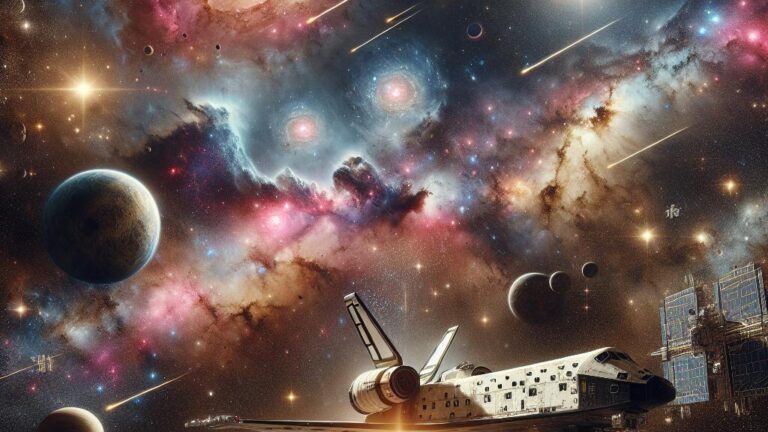Sustainable Practices in Space Travel
As the fascination with space exploration intensifies, the urgency for sustainable practices becomes ever more critical. Space missions, often teetering on the brink of resource depletion both here on Earth and in the cosmos, raise alarms about our reliance on finite supplies. Enter renewable energy—solar power shines as a beacon of hope, promising to drastically cut down our dependence on exhaustible fuels while slashing waste produced by launches into orbit. And let’s not overlook those cutting-edge propulsion systems: electric and ion thrusters are rewriting the rules of efficiency; they empower spacecraft to zip through the void at blistering speeds while sipping energy like it’s fine wine.
But wait! The quest for sustainability isn’t confined merely to how we propel ourselves among the stars. No, indeed! Space agencies and nimble private enterprises are delving into in-situ resource utilization (ISRU). Imagine extracting materials from celestial bodies themselves—a game-changer that could shrink our cargo loads launched from Earth! Furthermore, recycling systems designed for air and water aboard spacecraft emerge as lifelines for long-duration missions. These innovative strategies do more than just bolster prospects for sustained habitation beyond our blue planet; they embody a profound commitment to reducing humanity’s environmental footprint in realms far removed from home.
Addressing Environmental Concerns
The surge in space travel sparks a whirlwind of inquiries about its environmental footprint—both on our home planet and the vastness beyond. Each rocket launch unleashes a torrent of greenhouse gases and various pollutants, fueling climate change and shifting atmospheric conditions in ways that are alarming. And let’s not forget the looming threat of space debris, which hangs like a sword over satellites and upcoming missions. With the industry now booming, it’s imperative to forge ahead with cleaner propulsion technologies and sustainable practices to counter these escalating issues.
Amidst this chaos, innovative solutions are blossoming to tackle these formidable challenges. Companies are diving into reusable rocket designs that drastically cut down on the frequency of launches while minimizing waste—a game changer! Moreover, there’s an exciting wave of research focused on alternative fuels and propulsion systems; think electric or hydrogen-driven engines—these avenues shimmer with potential for slashing emissions. And let’s be clear: prioritizing sustainability in planetary missions isn’t just wise; it safeguards other celestial bodies from contamination, ensuring humanity embarks on its cosmic adventures armed with responsibility and care.
Human Presence on Other Planets
The endeavor to establish a human foothold on other planets is fraught with colossal challenges yet bursting with thrilling possibilities. At the forefront of this cosmic ambition lies Mars, our prime candidate for colonization, thanks largely to its intriguing resemblances to Earth. Researchers are diving deep into innovative technologies aimed at crafting sustainable life support systems and efficient habitats while also hunting down reliable food sources amidst the Martian dust. In a remarkable display of global unity, space agencies from various corners of the world are banding together on missions that seek not just to explore but truly grasp the complexities of the Martian environment—a crucial step in assessing whether long-term human expeditions can indeed become reality.
Yet, let us not overlook our celestial neighbor—the Moon—serving as an invaluable launchpad for humanity’s future explorations beyond our home planet. It offers a proximate arena where we can rigorously test technologies and gauge how well humans might adapt under extraterrestrial conditions. Ambitious plans for lunar bases are currently taking shape, emphasizing the clever utilization of local resources such as water ice—not only vital for sustaining life but also pivotal in fueling further ventures into space. This foundational groundwork will ultimately pave the way for bolder missions deeper into our solar system, fundamentally transforming humanity’s understanding of its role within this vast universe we inhabit.
Mars Colonization Efforts
The endeavor of establishing a human foothold on Mars is riddled with an array of technical and logistical conundrums, each more intricate than the last. Picture this: life support systems that not only survive but thrive amidst the unforgiving Martian landscape. It’s no small feat—engineers and scientists must conjure technologies that can deliver food, water, and oxygen for extended stays in an environment that seems designed to challenge every ounce of human ingenuity.
And then there’s the matter of transporting materials from our blue planet to the red one—a puzzle begging for innovative solutions! The quest for cost-effective methods coupled with heightened efficiency fuels feverish brainstorming sessions among researchers.
Meanwhile, teams are diving headfirst into designs for habitats capable of shielding inhabitants from cosmic radiation and bone-chilling temperatures. Various concepts are emerging like phoenixes from the ashes—sustainable living spaces crafted with an eye toward utilizing Martian resources themselves. This approach aims to lessen dependency on Earth-supplied materials as we reimagine what it means to live off-planet.
Yet amid all these ambitions lies a pressing concern: how do we safeguard astronauts’ health during their interplanetary sojourn? This question drives rapid advancements in medical technology and meticulous emergency protocols, ensuring that when humanity finally sets foot on Mars, it does so prepared—not just to survive but to flourish in its alien embrace.
The Importance of Space Research
Space research is nothing short of a cosmic catalyst, propelling our quest for understanding the vast universe while simultaneously enhancing life right here on Earth. It’s an engine of innovation, sparking groundbreaking advances across diverse fields like medicine, engineering, and environmental science. The technologies birthed from space missions often weave their way into the fabric of daily existence—boosting efficiency and safety in a multitude of industries.
Moreover, when we set our sights on distant celestial bodies, we unlock secrets about the origins and evolution of our own planet. By delving into the atmospheres and terrains of other worlds, we gain crucial insights that illuminate fundamental processes shaping climate change and geological dynamics here at home. This relentless pursuit for knowledge through space exploration doesn’t just broaden horizons; it builds bridges—fostering global collaboration as nations unite to confront urgent challenges facing humanity.
In this shared endeavor, space transcends its role as merely a final frontier—it emerges as a potential nexus for international unity and progress. With each mission launched into the abyss above us comes not only discovery but also inspiration—a powerful nudge toward curiosity that beckons future generations to embark on journeys within science, technology, engineering, and mathematics (STEM).
Enhancing Life on Earth
Throughout history, the realm of space exploration has birthed a plethora of technological marvels—each one eventually worming its way into our daily lives here on Earth. What began as ingenious solutions crafted for the unforgiving expanse of outer space has morphed into vital tools across diverse fields like medicine, telecommunications, and resource management. For example, those high-tech materials engineered to insulate spacecraft from extreme temperatures have now found their niche in energy-efficient building products that keep us cozy while conserving power. Likewise, satellite technology isn’t just floating up there; it plays an instrumental role in agricultural oversight and disaster response efforts—bolstering food security and refining strategies for tackling natural calamities.
But wait! There’s more: the enigmatic research conducted amidst the microgravity ballet offers treasures of knowledge that could revolutionize our health and everyday existence. By delving into how materials behave or biological systems function under these unique conditions, scientists are unlocking breakthroughs in drug development and unraveling the mysteries behind various diseases. Such discoveries don’t merely pave smooth roads toward innovative medical treatments; they also expand our understanding of how living organisms adapt when thrust into extremes. This fascinating overlap between cosmic inquiry and earthly application underscores just how profoundly space initiatives can enhance life right here on our beloved planet!
Future Spacecraft Designs
The realm of spacecraft design is undergoing a fascinating metamorphosis, where the spotlight shines brightly on boosting efficiency and safety for those audacious future missions that await us among the stars. Engineers—those modern-day alchemists—are weaving advanced materials and cutting-edge propulsion systems into their blueprints with increasing fervor. The goal? To shed weight from these celestial chariots while simultaneously fortifying them against the unforgiving embrace of space’s harshest environments.
Consider modular designs, which sprout like inventive wildflowers in this garden of technology; they promise adaptability in assembly and reconfiguration, tailoring each craft to its specific mission needs as if it were a bespoke suit crafted from stardust itself.
Meanwhile, an exhilarating exploration unfolds around alternative energy sources—a veritable treasure trove in the development of space vehicles. Solar sails unfurl like great wings catching cosmic winds, while nuclear propulsion systems beckon with visions of long-duration voyages far beyond the constraints of traditional fuel paradigms. Envisioning such technologies could slash transit times to far-flung realms, rendering journeys to Mars or even further out into our solar system not just dreams but tangible pursuits within our grasp!
This relentless evolution in spacecraft design stands as a pivotal force propelling humanity’s aspirations deeper into the cosmos—a thrilling chase toward expansion that echoes through time and space!
Concepts for Next-Generation Vehicles
Next-generation spacecraft designs are bursting with innovation, aiming to elevate efficiency, sustainability, and safety to unprecedented heights. Picture engineers weaving together cutting-edge materials that not only shed weight but also amplify durability—it’s a delicate dance of science and creativity! These groundbreaking advancements aren’t just for show; they’re meticulously crafted to slash fuel consumption and enhance propulsion systems, creating a ripple effect that benefits both daring exploratory missions and the burgeoning realm of commercial travel. Concepts like electric or hybrid propulsion systems are gaining momentum—like a rocket igniting at launch—ushering in an era of eco-conscious space exploration.
But wait! There’s more than just propulsion wizardry at play here. Modular designs are shaking up the very foundations of spacecraft architecture. Imagine vehicles morphing seamlessly to tackle diverse missions—a true testament to versatility and savvy resource management! Features like expandable habitats emerge as beacons of hope for long-duration journeys, striking a balance between crew comfort and operational prowess. All these thrilling developments herald a monumental shift towards innovative, practical, and sustainable strategies in the realms of human and robotic spaceflight—it’s an exhilarating time to gaze upward into the cosmos!
| Spacecraft Concept | Propulsion System | Key Feature | Mission Type |
|---|---|---|---|
| Orion Multi-Purpose Crew Vehicle | Liquid Rocket Engines | Modular Design | Crewed Mars Missions |
| Dream Chaser | Hybrid Propulsion | Reusable Spaceplane | Commercial Cargo/Passenger Flights |
| Lunar Gateway | Electric Propulsion | Expandable Habitats | International Lunar Missions |
| Starship | Raptor Engines | Fully Reusable | Interplanetary Travel |
The Ethical Implications of Space Travel
The quest for space travel catapults us into a whirlwind of ethical dilemmas, swirling around far more than just the thrill of scientific discovery. Consider the tantalizing prospect of colonizing other planets—does it not spark fiery debates about the rights owed to alien ecosystems? What happens when human footprints mar untouched celestial terrains? The very thought sends shivers down our spines as we grapple with how our actions might reverberate through these fragile environments.
Then there’s the matter of pilfering resources from distant worlds—a conundrum that raises eyebrows and alarms alike. Who truly owns these cosmic treasures, and can we claim stewardship over them without first reckoning with Earth’s environmental ethics? In this grand tapestry of ambition woven against responsibility, humanity stands at a precipice, peering beyond its home planet with both excitement and trepidation.
Let’s not overlook another layer: what does it mean to have humans out there in the cosmos? As we gaze into an interstellar future, we must ponder deeply on how such ventures could reshape society for generations yet unborn. Introducing terrestrial life forms to alien landscapes—oh! The risks loom large like dark clouds overhead—contamination and ecological upheaval could be lurking right around the corner. This underscores an urgent call for a robust ethical framework guiding our celestial ambitions; one that ensures both Earth and potential new realms are nurtured rather than ravaged in this audacious leap into infinity.
Considerations for Future Generations
As we stretch our ambitions into the vast, star-speckled tapestry of the cosmos, one can’t help but ponder the tangled ethical threads woven through our celestial pursuits. The choices we make today—those audacious steps toward space travel and colonization—will echo through time, casting shadows on future generations yet to even dream of what lies beyond our atmosphere. These decisions could sculpt not just their realities, but also redefine humanity’s very essence in relation to the universe that cradles us.
It’s imperative that we ensure tomorrow’s explorers flourish without retracing the environmental missteps of yesteryear. This calls for a radical evolution in how we educate ourselves about these extraterrestrial journeys. We must nurture an acute sense of responsibility towards these ventures far from home—a preparation for challenges unfathomable today. Our educational frameworks should transcend mere scientific prowess; they need to embrace a wider spectrum that includes ethical dilemmas and cultural reverberations.
By cultivating a mindset rich in sustainability and interplanetary empathy, society can bolster this next generation of trailblazers as they navigate the intricate moral labyrinths awaiting them among the stars. In doing so, we’ll equip them not only with knowledge but also with wisdom—a compass guiding them through uncharted territories where every decision carries weighty consequences.
- Emphasize sustainability in space exploration to protect potential extraterrestrial environments.
- Integrate ethical education into STEM curricula to prepare future astronauts and scientists.
- Promote awareness of cultural implications when interacting with new worlds and potential alien civilizations.
- Foster collaboration among nations to share knowledge and responsibility in space endeavors.
- Encourage public discourse about the philosophical and ethical implications of space colonization.
- Develop policies that prioritize the long-term impacts of space missions on future generations.
- Advocate for inclusion of diverse perspectives in space exploration planning and decision-making.
Conclusion
As humanity teeters on the edge of a thrilling new chapter in space exploration, the ramifications of our cosmic escapades ripple far beyond starlit skies. With an ever-growing emphasis on sustainable practices and ethical dilemmas, the future of interstellar travel stands ready to mirror our shared obligations. Each leap forward—be it cutting-edge spacecraft designs or the tantalizing prospect of human life on distant planets—demands a keen awareness of environmental footprints and societal consequences.
The pursuit to venture into—and perhaps settle on—other worlds not only sparks wild imaginations but underscores an urgent need for robust research and development. The dance between bold ambition and prudent caution will be pivotal in ensuring that our technological strides enhance life both here at home and across the vast universe. By embracing these multifaceted challenges, we can carve pathways toward revolutionary breakthroughs that honor our duties to Earth while fueling our dreams among the stars.
FAQS
What are some sustainable practices being implemented in space travel?
Ah, the cosmos beckons with its wonders, yet we tread lightly! Sustainable practices in this celestial dance encompass a tapestry of renewable energy sources weaving through the fabric of our missions. Picture recycling systems – intricate webs for reclaiming water and air, alongside innovative biodegradable materials crafted for spacecraft components. These endeavors strive to temper the environmental footprint left behind as we embark on our galactic journeys.
Why is addressing environmental concerns important in space travel?
The urgency of addressing environmental concerns cannot be overstated! Space exploration, while thrilling, carries the potential weighty consequences of pollution and resource depletion back home on Earth. By embracing sustainable practices, we forge a path that safeguards our planet’s health amidst our quest to explore the stars.
What are the current efforts for Mars colonization?
The saga of Mars colonization unfolds before us! Current initiatives involve robotic emissaries scouring the Martian terrain and scrutinizing its atmosphere—an interplanetary reconnaissance mission if you will—coupled with ambitious plans for human voyages into this red frontier. Titans like NASA and SpaceX are delving deep into research aimed at habitat construction technologies, life support frameworks, and even pioneering sustainable agriculture under alien skies!
How does space research benefit life on Earth?
The dividends of space research spill over into everyday existence! Advancements born from gazing skyward enhance technology across myriad domains—from revolutionizing communication systems to bolstering disaster response mechanisms—all while shedding light on climate change enigmas. Innovations conceived amid cosmic pursuits often find their way back down to Earth’s embrace, uplifting society as a whole.
What are the key features of next-generation spacecraft designs?
Next-gen spacecraft designs emerge from an alchemical blend of ingenuity and necessity! They prioritize heightened energy efficiency paired with cutting-edge propulsion systems that hum with promise; safety features designed to cradle crew members; all wrapped up in enhanced habitability standards. These ingenious blueprints aspire not only for longer missions but also aim toward explorations that extend far beyond Mars itself!
What ethical implications should be considered for future space travel?
As we gaze upon tomorrow’s horizon in space travel, ethical quandaries loom large! We must grapple with questions surrounding contamination risks posed to distant celestial bodies or ponder what rights might belong to any extraterrestrial beings lurking out there among the stars. Humanity bears responsibilities toward sustainable exploration—and let’s not forget how burgeoning interests like space tourism could shape resource allocation priorities now and well into future generations!
What is the significance of the conclusion in discussions about the future of space travel?
In summation—the conclusion serves as both a mirror reflecting advancements we’ve achieved thus far whilst casting forward onto paths yet unexplored! It underscores sustainability’s pivotal role alongside collaboration intertwined with profound ethical considerations essential for our forthcoming odysseys amongst galaxies unknown. This call-to-action fosters dialogue about our shared responsibilities as stewards navigating beyond terrestrial bounds—a conversation imperative as we reach ever upward.







